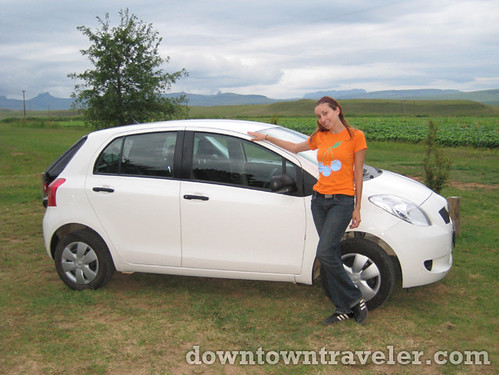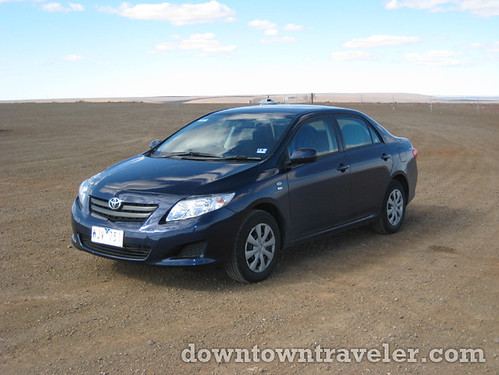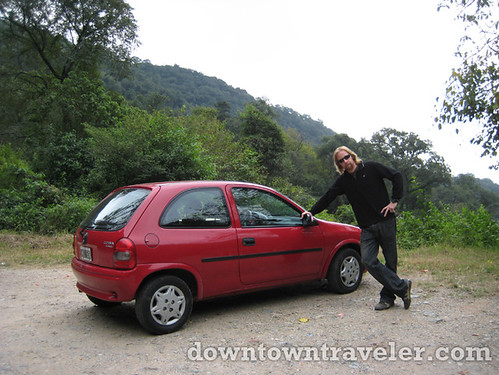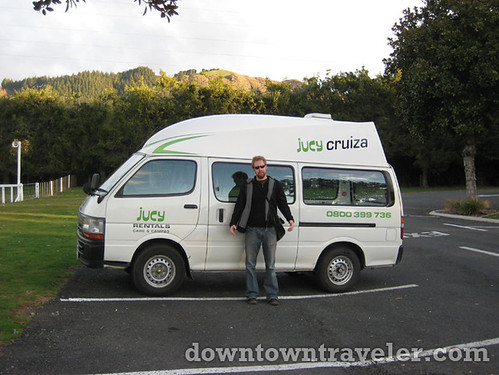Renting a car in the United States is fairly straightforward these days, but renting overseas can to lead to many unforeseen headaches.
I’ve now driven rental vehicles in 11 different countries, with experiences ranging from fantastic to cringe-worthy. While each country has its own specific challenges, I now realize that I could have minimized or avoided most of the problems I’ve had by taking a few simple steps during my trip.
Read on for my top 5 tips for renting and driving a car overseas– hopefully you will learn from my mistakes!
Tip #1: Rent from a large U.S. based chain, if possible.
You might find a slightly cheaper deal by renting a car from a smaller chain based in the country you are visiting. While the price may be tempting, consider this: If you run into a problem with the car rental, you often have little or no recourse– especially if you discover the error weeks or even months after you’ve returned home. That’s why I prefer to rent through large international companies; they have formal customer service departments and generally want to avoid bad PR. With a U.S.-based company you’ll have the option to complain to the Better Business Bureau if the company does not respond to your initial complaints.
After renting a car in South Africa, we received hundreds of dollars in erroneous charges for a missing spare tire and jack (more on this later). We contacted the local rental office several times to dispute the charge and could barely get a response, much less a refund. Since this was an international company, we contacted their U.S. headquarters and eventually filed a complaint with the Better Business Bureau, which resulted in an immediate refund of all charges. Trying this with a small foreign rental car company would be impossible.

Our rental car in South Africa left us stranded after a flat tire-- and resulted in hundreds of dollars in erroneous charges.
Tip #2: Always check the spare tire and jack before renting.
When renting, it’s common practice to do a walk-around inspection of the car to make sure the agent notes every dent and scratch already on the vehicle. However, most rental companies don’t take the extra step of showing you the spare tire and jack. On more than one occasion we’ve run into problems because of this. Now we always make sure to check the location and condition of both the tire and jack, and I suggest you do too.
While traveling on a highway in rural South Africa, I unexpectedly got a flat tire. After searching the car for the jack I realized it was missing, forcing me to walk a few miles down the isolated road to a gas station. To make matters worse, I was eventually charged a couple of hundred dollars for losing the jack and was only reimbursed after complaining to the Better Business Bureau. (See tip #1 above).
A similar issue popped up on a recent trip to Curacao. This time we requested to see the spare tire and jack but we didn’t actually touch the tire. Of course, with our luck, it turned out to be low on air! Although we never got a flat or even touched the spare tire on this trip, the rental company charged a small fee for refilling the tire after we returned it. Because of this, I urge you to check before leaving the rental lot that the spare and jack are where they are supposed to be, and that the spare tire is full of air.

Our compact Toyota rental got us through two months in Australia, including 2 weeks in the Outback, without a problem.
Tip #3: Get automatic transmission when available.
When renting a car you usually have a choice of manual or automatic transmission; automatic typically costs a few dollars more per day. Unless you are really pinching pennies, however, it’s worth a (small) splurge to get automatic. Although I learned to drive on a stick shift, I’ve found that manual transmission makes driving overseas much more complicated.
Figuring out the rules of the road in a foreign country is enough to worry about, without having to focus on switching gears. This is especially true when you find yourself in a country that drives on the other side of the road from what you are used to.
If you think driving on the left is hard (compared to North America, where we drive on the right), wait until you try it while shifting with your left hand. It’s not easy to get used to!
Tip #4: If you have a rental problem, file a complaint on the spot.
Don’t wait until you get home to file a complaint over erroneous charges or other rental problems. If you are confronted with unexpected charges when you return a car, some rental agencies will let you submit a written complaint on the spot. This can lead to errant charges getting corrected much more quickly than fighting the charge when you return home– and it beats having to deal with a maze of automated phone numbers and emails. Be sure to save a copy of any complaint you file (or snap a photo of the documents you submit), since you may need this documentation to pursue your claim when you return home.
When we were charged a nominal fee for the flat spare tire in Curacao, we were told we could immediately file a complaint that would be sent to the supervisor’s office in Willemstad. I wrote out a letter explaining the problem and why we shouldn’t be charged, and snapped a photo of it on my iPhone. The credit card charge was reversed within two weeks of our return home.

Our road trip through Northern Argentina took me through the most disorganized and dangerous roads I've ever driven in.
Tip #5: Learn the local driving rules– and stay calm!
The more countries I drive in, the more unique driving rules and customs I come across. In general, you’ll do fine if you just drive patiently and follow what everyone else is doing. For example, roundabouts are something you’ll encounter in many foreign countries; they often replace the stop lights we are accustomed to in the United States. Roundabouts can seem very strange and confusing at first, but if you drive slowly and always yield to the left you’ll get the hang of it in no time.
No two countries are exactly the same when it comes to driving conditions. Some are very orderly, while others are completely chaotic. I’ve enjoyed driving in Australia and New Zealand, which have clearly-marked roads and drivers who are surprisingly slow and non-aggressive. In other countries, like Argentina, there sometimes appear to be no rules at all. In Salta and Jujuy provinces, I drove through heavily-trafficked, four-way intersections with no stop signs or clear right of way.
The bottom line
Driving a car overseas has many benefits: getting off the tourist trail, interacting with locals in small towns and cities, and saving money by not taking a package tour. In addition, driving overseas will make you that much more relaxed when you drive back home. I used to hate driving through the crowded streets of Manhattan, but after the chaos of many foreign cities it’s now a breeze.


















I’ve never attempted to drive in another country. I wouldn’t be able to enjoy it or relax! Looks like you two are pros!
It’s not that bad once you get the hang of it…tho I’ve been forced to do all the driving since Leslie refuses to!
Well you are such a wonderful driver, I don’t want to ruin your good time 🙂
Great article! We will certainly use the advice in the future! We’ll skip driving in Salta and Jujuy, though.
Thanks for the comment! Yes, driving in rural Argentina is an adventure sport 🙂
I was really nervous about driving in my three-week vacation in New Zealand since I’d never driven on the left. Much to my surprise, I did great. In fact, two weeks after I got back, I found myself driving on the left. Oops! Great tips. Thanks!
Yikes! Hope you discovered you were driving on the wrong side of the road before getting pulled over 😉 Thanks for your comment.
I would add… Buy the extra insurance! Twice I’ve gotten into accidents and the extra insurance prevented me from paying THOUSANDS of dollars in damage repairs. Seriously, don’t be penny wise pound foolish on this one.
You never know when an accident could happen through your fault or someone else’s.
Great tip! It’s a good idea to get the extra travel insurance (although we haven’t needed it so far).
Great tips! In some countries it helps to take photos because they try to scam you into paying more saying there were no dents initially etc. etc. Nice job, Leslie!
Nice post.
For #6, I’d add something very important. Very carefully inspect the entire surface of the vehicle and have the rental agency document even the smallest damage in writing, giving a copy to you, before you drive away.
Thailand is a beautiful country and popular tourist destination. With an excellent road infrastructure and numerous attractions spread far and wide, it is also better to self drive than making use of public transport. If you follow the car hire tips provided below you will be able to save money and have a safe as well as pleasant journey.
Major Cities
The best pick-up and drop-off locations for car hire in the country are the airports. Major airports are located in Johannesburg, Nelspruit, Cape Town, Durban, George, East London, and Bloemfontein.
Car Hire Tips for Safety
The roads are relatively safe, but be vigilant, especially when driving at night or on small roads. Don’t stop for picnics at the roadside picnic spots, unless at one of the fuel station and refreshment centres. Beware of potholes also in the city areas and don’t engage in conversation with people at the intersections. You will find street vendors and beggars at many of the intersections. Be careful as some of them are involved in smash and grab attempts and hijackings and simply use the begging or hawking to disguise their real intentions. Keep your windows rolled up and don’t leave any valuables in sight. Drive with vehicle doors locked and be sure to let someone know where you are going.